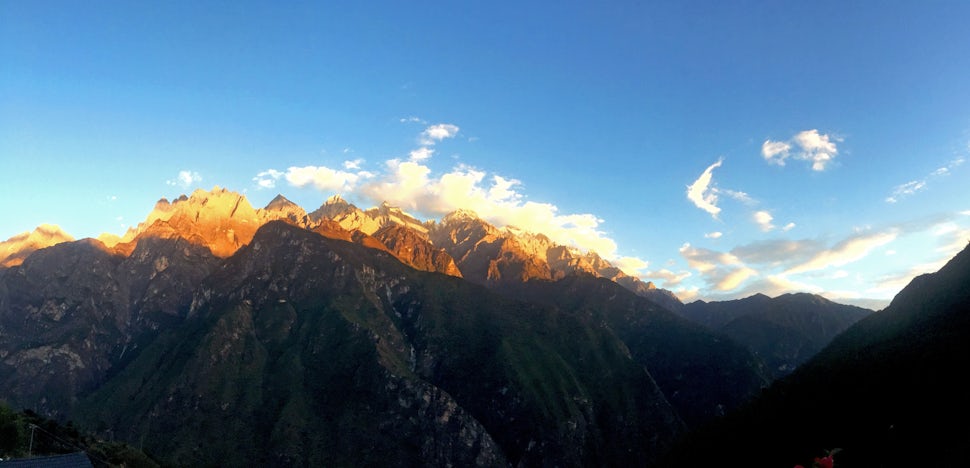Tiger Leaping Gorge: Traversing the Heart of Yunnan
The mighty Yangtze River careened through the weathered rocks as if a thunderous explosion occurred. The ancient limestone cliffs surrendered to the incalculable force that the river exerted. Above, two mountains pierce the sky, separated by the chasm created by this forceful river. This is the Tiger Leaping Gorge.

An early morning saw myself and my wife, Mary, on a rickety old bus moving upwards into the wilds of Yunnan. With the lights of Lijiang fading into the background, two mountains juxtapose their will on the landscape - the Jade Dragon Snow Mountain at 18,359 ft and the Haba Snow Mountain at 17,703 ft. Being taught in geology, the way is clear as ever - we are headed towards a colossal canyon that separates these two mountains, forged over millions of years by the Yangtze River. The gorge, named the Tiger Leaping Gorge due to an ancient myth where a tiger was seen to leap across the river at its narrowest point, extends to depths over 12,000 ft. This is staggering considering it is only surpassed by that of the Yarlung Tsangpo Canyon of the Eastern Himalayas. Yunnan is known throughout China and the world for its unrivaled diversity as it is home to more than 20 different ethnic minorities and more than 50 percent of China's plant species. The three-hour drive from Lijiang, a Naxi hamlet and fertile valley, to Qiaotou, with increasing Tibetan influence and glaciated peaks, represents a fraction of Yunnan's diversity.
When our bus arrived in Qiaotou, the staging point of the trek, the uninspired architecture nearly choked out our aspirations of adventure. Smoke flumes, exhaust, honking vehicles, and boxed buildings seemed out of place for a wild gorge that was recently opened to tourists - that is, in the last 25 years. We overcame our initial impressions and walked over the bridge of the Yangtze River right before it carved its eternal initials on the landscape. An equally uninviting building served as the ticket office - a bargain at 65 yuan. We unashamedly bypassed the first several miles of the trek, which served more as an amphitheater to human intervention rather than nature's, by paying a vehicle to drive us up the steep slope. As it was already past noon, we wanted to ensure we could find a resting point before dark while still enjoying the landscape.
We began the trek with fresh legs as the hot sun glistened the snow-encrusted peaks. The shade was sparse as the vegetation consisted of shrubbery. The trail was a dirt path meandering the natural curves of the mountain. Locals and hikers were sparse at the initial miles, but were enough to motivate us to move forward. The Naxi, the native people who are the last remaining hieroglyphic writers on Earth, moved back and forth on these trails, looking for travelers such as ourselves to offer their horses to carry us up the slopes. We gently declined and pressed forward. Other Naxi's offered us Snicker bars and overpriced bottles of water. Even more entrepreneurial were the locals who charged to set foot on the best view points over looking the Yangtze River thousands of feet below. In a place that has exploded in visitors in recent decades, the trend of locals trying to earn their wage off travelers was understandable.
Along the trek of the upper slope lied the nearly legendary 28 bends, a series of switchbacks interweaving the topography of the cliffs. We passed them without even realizing. Further along waterfalls gushed over the rock walls, spraying the trail with a fine mist. Farmers and shepherds brought through their large herds of goats through the path, with their livestock leading the way. The goats themselves made fine hiking companions, despite a slight jealousy of their ease to traverse the terrain. The trail ascended and descended, but every turn offered new glimpses of the jagged peaks. A welcoming feature of this trek were the established guesthouses along the trail, offering simple accommodation and much needed hot meals. Much like the well-know treks in Nepal, the Tiger Leaping Gorge can be fully enjoyed without much preparation or load.
We arrived at our intended guesthouse just before dark. Run by a local family, it was appropriately called the Naxi Family Guesthouse. With a wonderfully placed wooden deck overlooking the Jade Dragon Snow Mountain and the Yangztze River thousands of feet below, we enjoyed the sun retreat for the day as it descended below the depths of the mountains, waiting to be seen the next day. The Tiger Leaping Gorge is a beautiful introduction to the seemingly endless and wild western China that lies beyond. With our legs resting for the night, we yearned for the next day where we would be face-to-face with one of nature's greatest forces, the lifeblood of China, and the heart of Yunnan - the mighty Yangtze River.
We want to acknowledge and thank the past, present, and future generations of all Native Nations and Indigenous Peoples whose ancestral lands we travel, explore, and play on. Always practice Leave No Trace ethics on your adventures and follow local regulations. Please explore responsibly!
Do you love the outdoors?
Yep, us too. That's why we send you the best local adventures, stories, and expert advice, right to your inbox.















